Engineering Research Methods: Commercial Drones Ethical Report
VerifiedAdded on 2023/05/29
|7
|1510
|191
Report
AI Summary
This report examines the ethical and social implications of commercial drones, starting with an introduction to their functionality as unmanned aerial vehicles (UAVs) and unmanned aircraft systems (UAS). It details the working principles of drones, including their use of rotors for propulsion and control, and the various technologies embedded within them, such as GPS and infrared cameras. The report then addresses the ethical issues arising from the use of commercial drones, focusing on privacy concerns and potential job displacement. It references the "Statement of Ethical Principles for the Engineering Profession" issued by the Engineering Council and the Royal Academy of Engineering, linking these principles to the responsible manufacturing and operation of drones. The conclusion summarizes the key points, emphasizing the need to address ethical dilemmas and privacy concerns. The report recommends that drones be used in industries where ethical dilemmas are minimal, and that engineers adhere to quality standards in manufacturing. It also suggests that drones should be operated by trained professionals who understand ethical standards and user manuals.
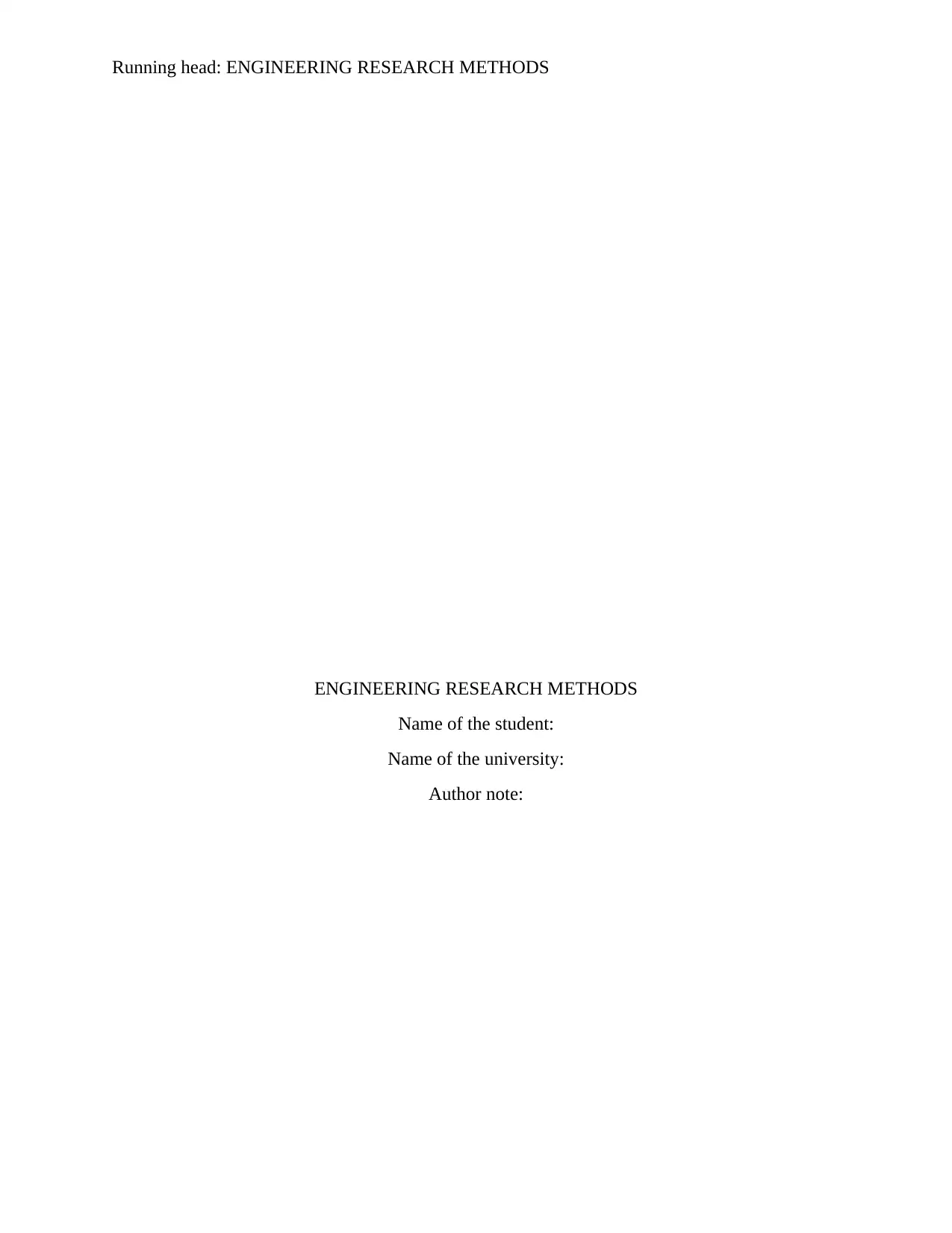
Running head: ENGINEERING RESEARCH METHODS
ENGINEERING RESEARCH METHODS
Name of the student:
Name of the university:
Author note:
ENGINEERING RESEARCH METHODS
Name of the student:
Name of the university:
Author note:
Paraphrase This Document
Need a fresh take? Get an instant paraphrase of this document with our AI Paraphraser
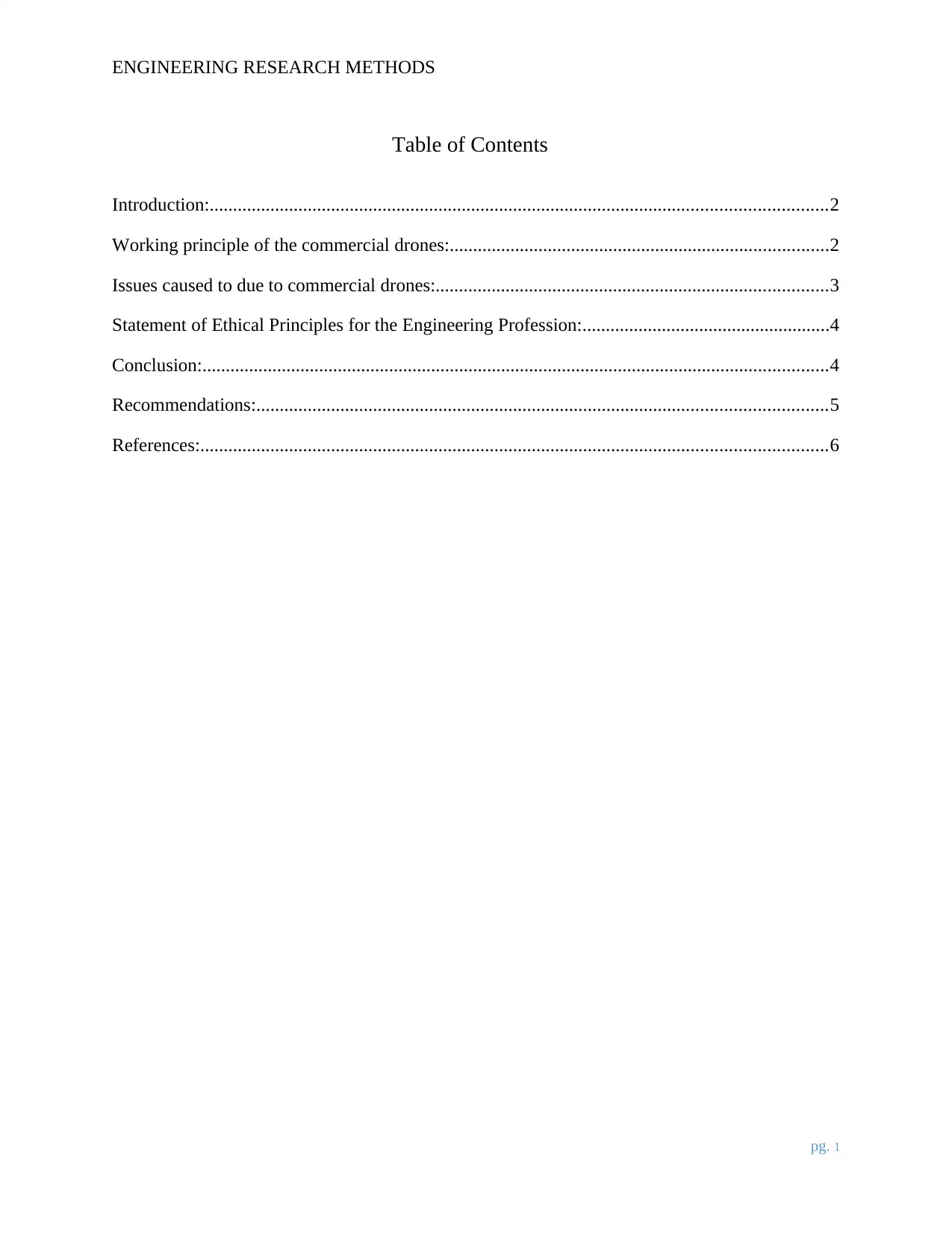
ENGINEERING RESEARCH METHODS
Table of Contents
Introduction:....................................................................................................................................2
Working principle of the commercial drones:.................................................................................2
Issues caused to due to commercial drones:....................................................................................3
Statement of Ethical Principles for the Engineering Profession:.....................................................4
Conclusion:......................................................................................................................................4
Recommendations:..........................................................................................................................5
References:......................................................................................................................................6
pg. 1
Table of Contents
Introduction:....................................................................................................................................2
Working principle of the commercial drones:.................................................................................2
Issues caused to due to commercial drones:....................................................................................3
Statement of Ethical Principles for the Engineering Profession:.....................................................4
Conclusion:......................................................................................................................................4
Recommendations:..........................................................................................................................5
References:......................................................................................................................................6
pg. 1
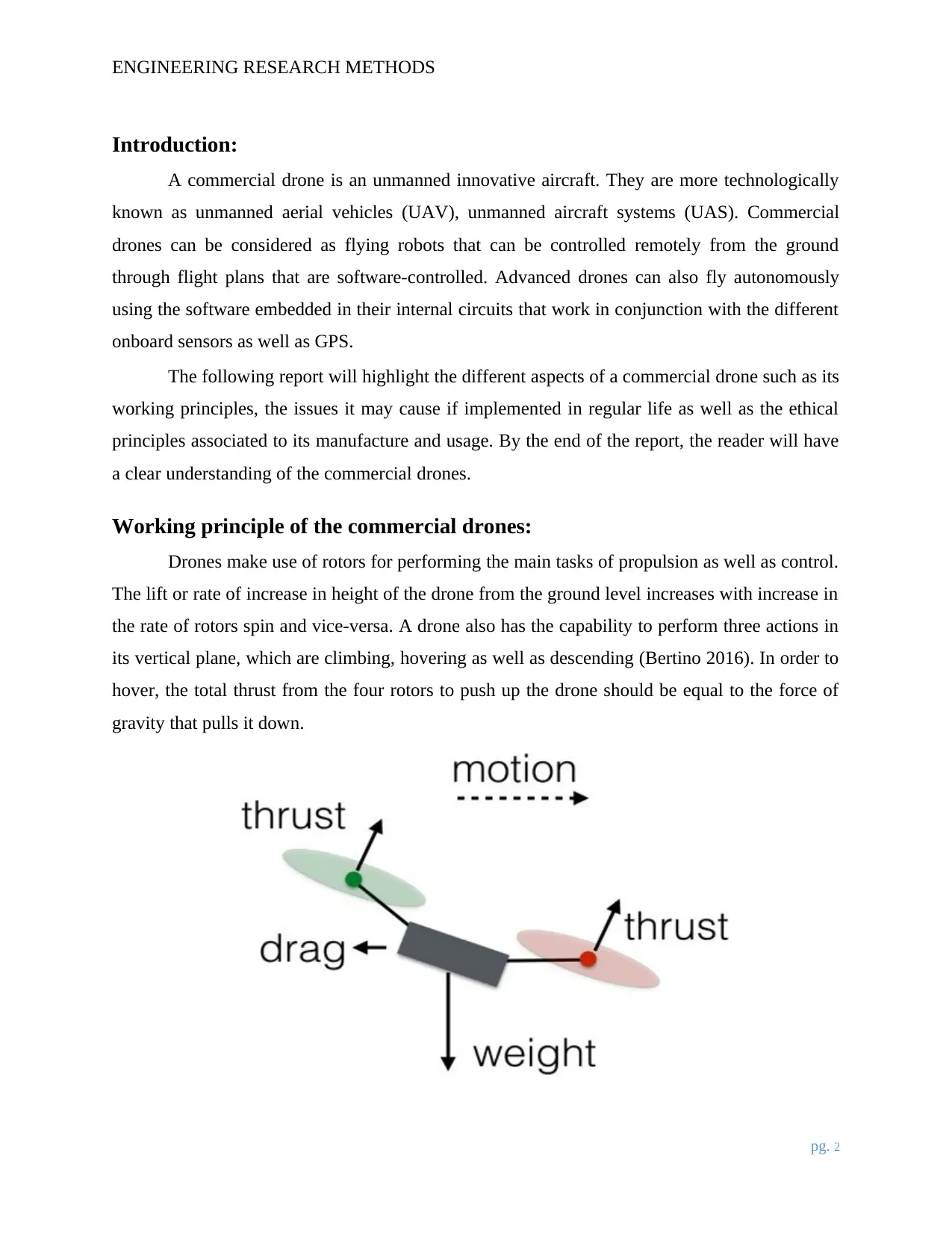
ENGINEERING RESEARCH METHODS
Introduction:
A commercial drone is an unmanned innovative aircraft. They are more technologically
known as unmanned aerial vehicles (UAV), unmanned aircraft systems (UAS). Commercial
drones can be considered as flying robots that can be controlled remotely from the ground
through flight plans that are software-controlled. Advanced drones can also fly autonomously
using the software embedded in their internal circuits that work in conjunction with the different
onboard sensors as well as GPS.
The following report will highlight the different aspects of a commercial drone such as its
working principles, the issues it may cause if implemented in regular life as well as the ethical
principles associated to its manufacture and usage. By the end of the report, the reader will have
a clear understanding of the commercial drones.
Working principle of the commercial drones:
Drones make use of rotors for performing the main tasks of propulsion as well as control.
The lift or rate of increase in height of the drone from the ground level increases with increase in
the rate of rotors spin and vice-versa. A drone also has the capability to perform three actions in
its vertical plane, which are climbing, hovering as well as descending (Bertino 2016). In order to
hover, the total thrust from the four rotors to push up the drone should be equal to the force of
gravity that pulls it down.
pg. 2
Introduction:
A commercial drone is an unmanned innovative aircraft. They are more technologically
known as unmanned aerial vehicles (UAV), unmanned aircraft systems (UAS). Commercial
drones can be considered as flying robots that can be controlled remotely from the ground
through flight plans that are software-controlled. Advanced drones can also fly autonomously
using the software embedded in their internal circuits that work in conjunction with the different
onboard sensors as well as GPS.
The following report will highlight the different aspects of a commercial drone such as its
working principles, the issues it may cause if implemented in regular life as well as the ethical
principles associated to its manufacture and usage. By the end of the report, the reader will have
a clear understanding of the commercial drones.
Working principle of the commercial drones:
Drones make use of rotors for performing the main tasks of propulsion as well as control.
The lift or rate of increase in height of the drone from the ground level increases with increase in
the rate of rotors spin and vice-versa. A drone also has the capability to perform three actions in
its vertical plane, which are climbing, hovering as well as descending (Bertino 2016). In order to
hover, the total thrust from the four rotors to push up the drone should be equal to the force of
gravity that pulls it down.
pg. 2
⊘ This is a preview!⊘
Do you want full access?
Subscribe today to unlock all pages.

Trusted by 1+ million students worldwide
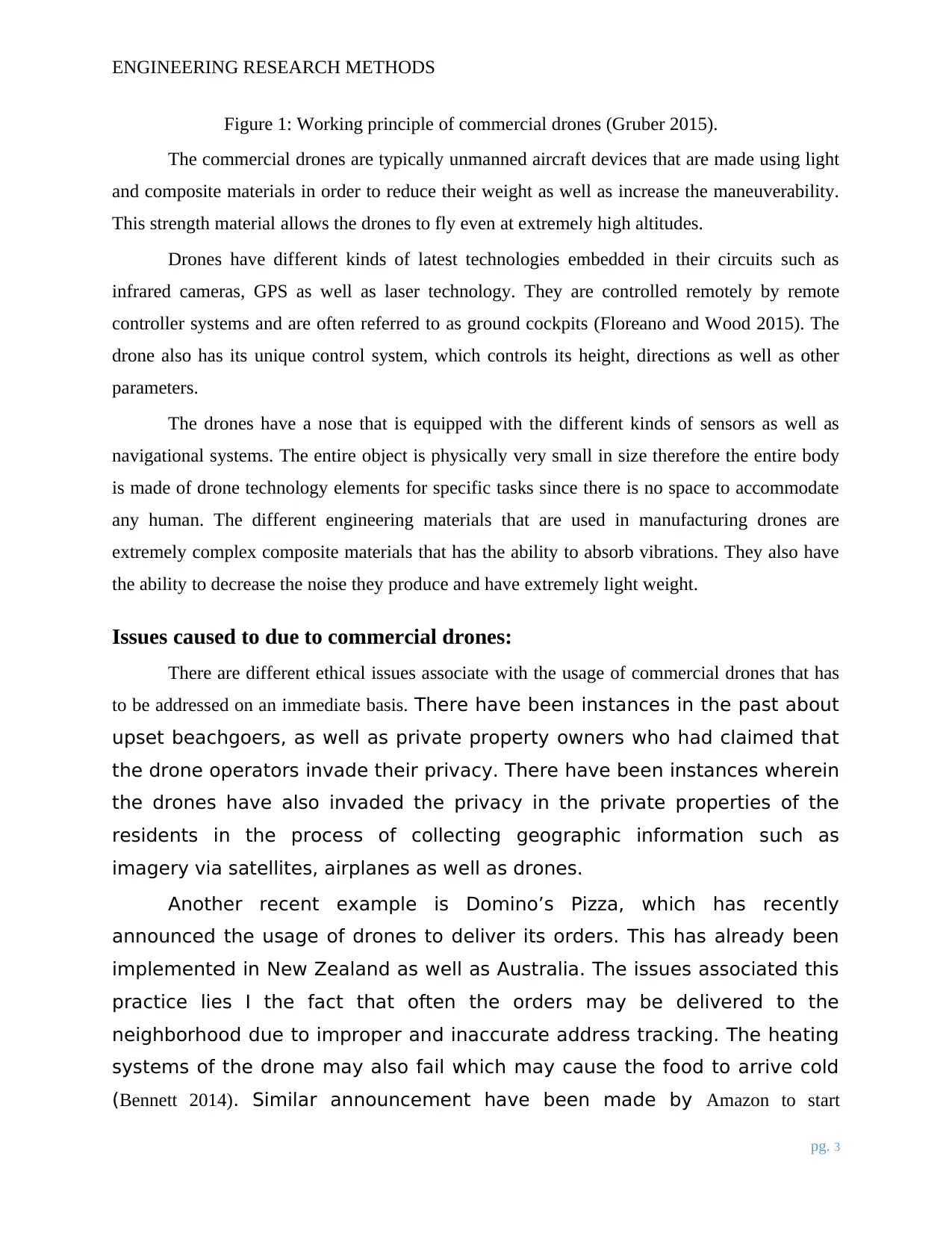
ENGINEERING RESEARCH METHODS
Figure 1: Working principle of commercial drones (Gruber 2015).
The commercial drones are typically unmanned aircraft devices that are made using light
and composite materials in order to reduce their weight as well as increase the maneuverability.
This strength material allows the drones to fly even at extremely high altitudes.
Drones have different kinds of latest technologies embedded in their circuits such as
infrared cameras, GPS as well as laser technology. They are controlled remotely by remote
controller systems and are often referred to as ground cockpits (Floreano and Wood 2015). The
drone also has its unique control system, which controls its height, directions as well as other
parameters.
The drones have a nose that is equipped with the different kinds of sensors as well as
navigational systems. The entire object is physically very small in size therefore the entire body
is made of drone technology elements for specific tasks since there is no space to accommodate
any human. The different engineering materials that are used in manufacturing drones are
extremely complex composite materials that has the ability to absorb vibrations. They also have
the ability to decrease the noise they produce and have extremely light weight.
Issues caused to due to commercial drones:
There are different ethical issues associate with the usage of commercial drones that has
to be addressed on an immediate basis. There have been instances in the past about
upset beachgoers, as well as private property owners who had claimed that
the drone operators invade their privacy. There have been instances wherein
the drones have also invaded the privacy in the private properties of the
residents in the process of collecting geographic information such as
imagery via satellites, airplanes as well as drones.
Another recent example is Domino’s Pizza, which has recently
announced the usage of drones to deliver its orders. This has already been
implemented in New Zealand as well as Australia. The issues associated this
practice lies I the fact that often the orders may be delivered to the
neighborhood due to improper and inaccurate address tracking. The heating
systems of the drone may also fail which may cause the food to arrive cold
(Bennett 2014). Similar announcement have been made by Amazon to start
pg. 3
Figure 1: Working principle of commercial drones (Gruber 2015).
The commercial drones are typically unmanned aircraft devices that are made using light
and composite materials in order to reduce their weight as well as increase the maneuverability.
This strength material allows the drones to fly even at extremely high altitudes.
Drones have different kinds of latest technologies embedded in their circuits such as
infrared cameras, GPS as well as laser technology. They are controlled remotely by remote
controller systems and are often referred to as ground cockpits (Floreano and Wood 2015). The
drone also has its unique control system, which controls its height, directions as well as other
parameters.
The drones have a nose that is equipped with the different kinds of sensors as well as
navigational systems. The entire object is physically very small in size therefore the entire body
is made of drone technology elements for specific tasks since there is no space to accommodate
any human. The different engineering materials that are used in manufacturing drones are
extremely complex composite materials that has the ability to absorb vibrations. They also have
the ability to decrease the noise they produce and have extremely light weight.
Issues caused to due to commercial drones:
There are different ethical issues associate with the usage of commercial drones that has
to be addressed on an immediate basis. There have been instances in the past about
upset beachgoers, as well as private property owners who had claimed that
the drone operators invade their privacy. There have been instances wherein
the drones have also invaded the privacy in the private properties of the
residents in the process of collecting geographic information such as
imagery via satellites, airplanes as well as drones.
Another recent example is Domino’s Pizza, which has recently
announced the usage of drones to deliver its orders. This has already been
implemented in New Zealand as well as Australia. The issues associated this
practice lies I the fact that often the orders may be delivered to the
neighborhood due to improper and inaccurate address tracking. The heating
systems of the drone may also fail which may cause the food to arrive cold
(Bennett 2014). Similar announcement have been made by Amazon to start
pg. 3
Paraphrase This Document
Need a fresh take? Get an instant paraphrase of this document with our AI Paraphraser
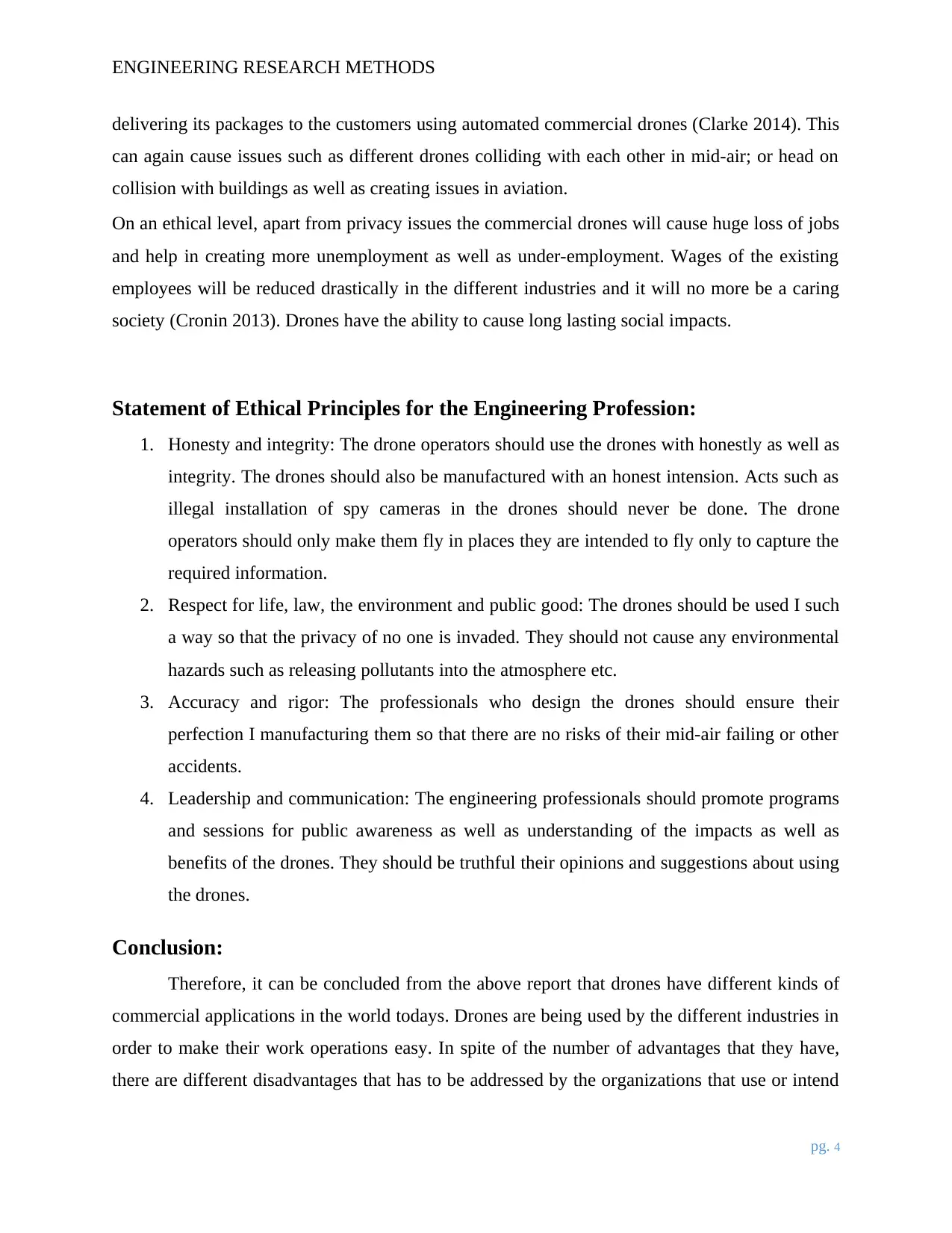
ENGINEERING RESEARCH METHODS
delivering its packages to the customers using automated commercial drones (Clarke 2014). This
can again cause issues such as different drones colliding with each other in mid-air; or head on
collision with buildings as well as creating issues in aviation.
On an ethical level, apart from privacy issues the commercial drones will cause huge loss of jobs
and help in creating more unemployment as well as under-employment. Wages of the existing
employees will be reduced drastically in the different industries and it will no more be a caring
society (Cronin 2013). Drones have the ability to cause long lasting social impacts.
Statement of Ethical Principles for the Engineering Profession:
1. Honesty and integrity: The drone operators should use the drones with honestly as well as
integrity. The drones should also be manufactured with an honest intension. Acts such as
illegal installation of spy cameras in the drones should never be done. The drone
operators should only make them fly in places they are intended to fly only to capture the
required information.
2. Respect for life, law, the environment and public good: The drones should be used I such
a way so that the privacy of no one is invaded. They should not cause any environmental
hazards such as releasing pollutants into the atmosphere etc.
3. Accuracy and rigor: The professionals who design the drones should ensure their
perfection I manufacturing them so that there are no risks of their mid-air failing or other
accidents.
4. Leadership and communication: The engineering professionals should promote programs
and sessions for public awareness as well as understanding of the impacts as well as
benefits of the drones. They should be truthful their opinions and suggestions about using
the drones.
Conclusion:
Therefore, it can be concluded from the above report that drones have different kinds of
commercial applications in the world todays. Drones are being used by the different industries in
order to make their work operations easy. In spite of the number of advantages that they have,
there are different disadvantages that has to be addressed by the organizations that use or intend
pg. 4
delivering its packages to the customers using automated commercial drones (Clarke 2014). This
can again cause issues such as different drones colliding with each other in mid-air; or head on
collision with buildings as well as creating issues in aviation.
On an ethical level, apart from privacy issues the commercial drones will cause huge loss of jobs
and help in creating more unemployment as well as under-employment. Wages of the existing
employees will be reduced drastically in the different industries and it will no more be a caring
society (Cronin 2013). Drones have the ability to cause long lasting social impacts.
Statement of Ethical Principles for the Engineering Profession:
1. Honesty and integrity: The drone operators should use the drones with honestly as well as
integrity. The drones should also be manufactured with an honest intension. Acts such as
illegal installation of spy cameras in the drones should never be done. The drone
operators should only make them fly in places they are intended to fly only to capture the
required information.
2. Respect for life, law, the environment and public good: The drones should be used I such
a way so that the privacy of no one is invaded. They should not cause any environmental
hazards such as releasing pollutants into the atmosphere etc.
3. Accuracy and rigor: The professionals who design the drones should ensure their
perfection I manufacturing them so that there are no risks of their mid-air failing or other
accidents.
4. Leadership and communication: The engineering professionals should promote programs
and sessions for public awareness as well as understanding of the impacts as well as
benefits of the drones. They should be truthful their opinions and suggestions about using
the drones.
Conclusion:
Therefore, it can be concluded from the above report that drones have different kinds of
commercial applications in the world todays. Drones are being used by the different industries in
order to make their work operations easy. In spite of the number of advantages that they have,
there are different disadvantages that has to be addressed by the organizations that use or intend
pg. 4
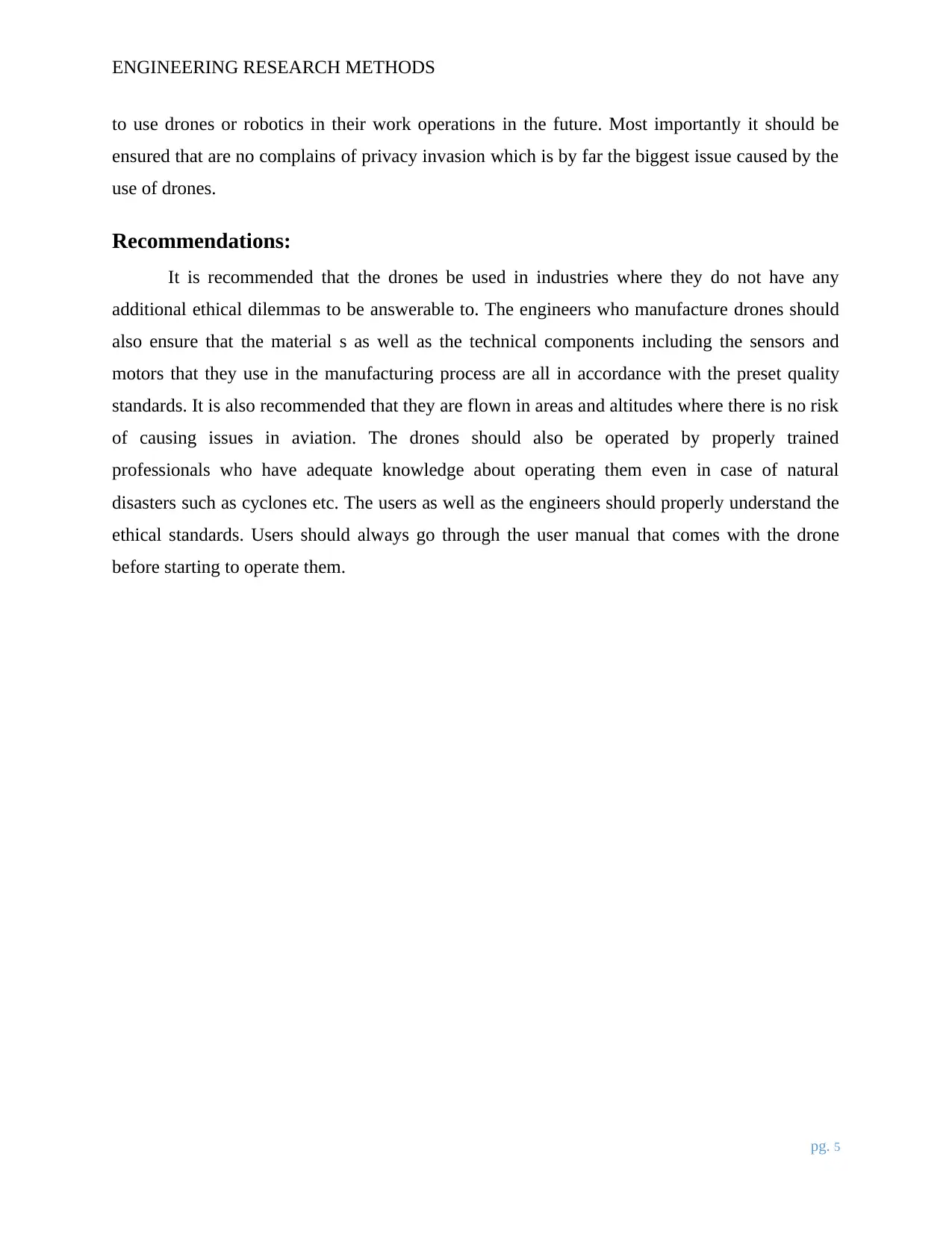
ENGINEERING RESEARCH METHODS
to use drones or robotics in their work operations in the future. Most importantly it should be
ensured that are no complains of privacy invasion which is by far the biggest issue caused by the
use of drones.
Recommendations:
It is recommended that the drones be used in industries where they do not have any
additional ethical dilemmas to be answerable to. The engineers who manufacture drones should
also ensure that the material s as well as the technical components including the sensors and
motors that they use in the manufacturing process are all in accordance with the preset quality
standards. It is also recommended that they are flown in areas and altitudes where there is no risk
of causing issues in aviation. The drones should also be operated by properly trained
professionals who have adequate knowledge about operating them even in case of natural
disasters such as cyclones etc. The users as well as the engineers should properly understand the
ethical standards. Users should always go through the user manual that comes with the drone
before starting to operate them.
pg. 5
to use drones or robotics in their work operations in the future. Most importantly it should be
ensured that are no complains of privacy invasion which is by far the biggest issue caused by the
use of drones.
Recommendations:
It is recommended that the drones be used in industries where they do not have any
additional ethical dilemmas to be answerable to. The engineers who manufacture drones should
also ensure that the material s as well as the technical components including the sensors and
motors that they use in the manufacturing process are all in accordance with the preset quality
standards. It is also recommended that they are flown in areas and altitudes where there is no risk
of causing issues in aviation. The drones should also be operated by properly trained
professionals who have adequate knowledge about operating them even in case of natural
disasters such as cyclones etc. The users as well as the engineers should properly understand the
ethical standards. Users should always go through the user manual that comes with the drone
before starting to operate them.
pg. 5
⊘ This is a preview!⊘
Do you want full access?
Subscribe today to unlock all pages.

Trusted by 1+ million students worldwide
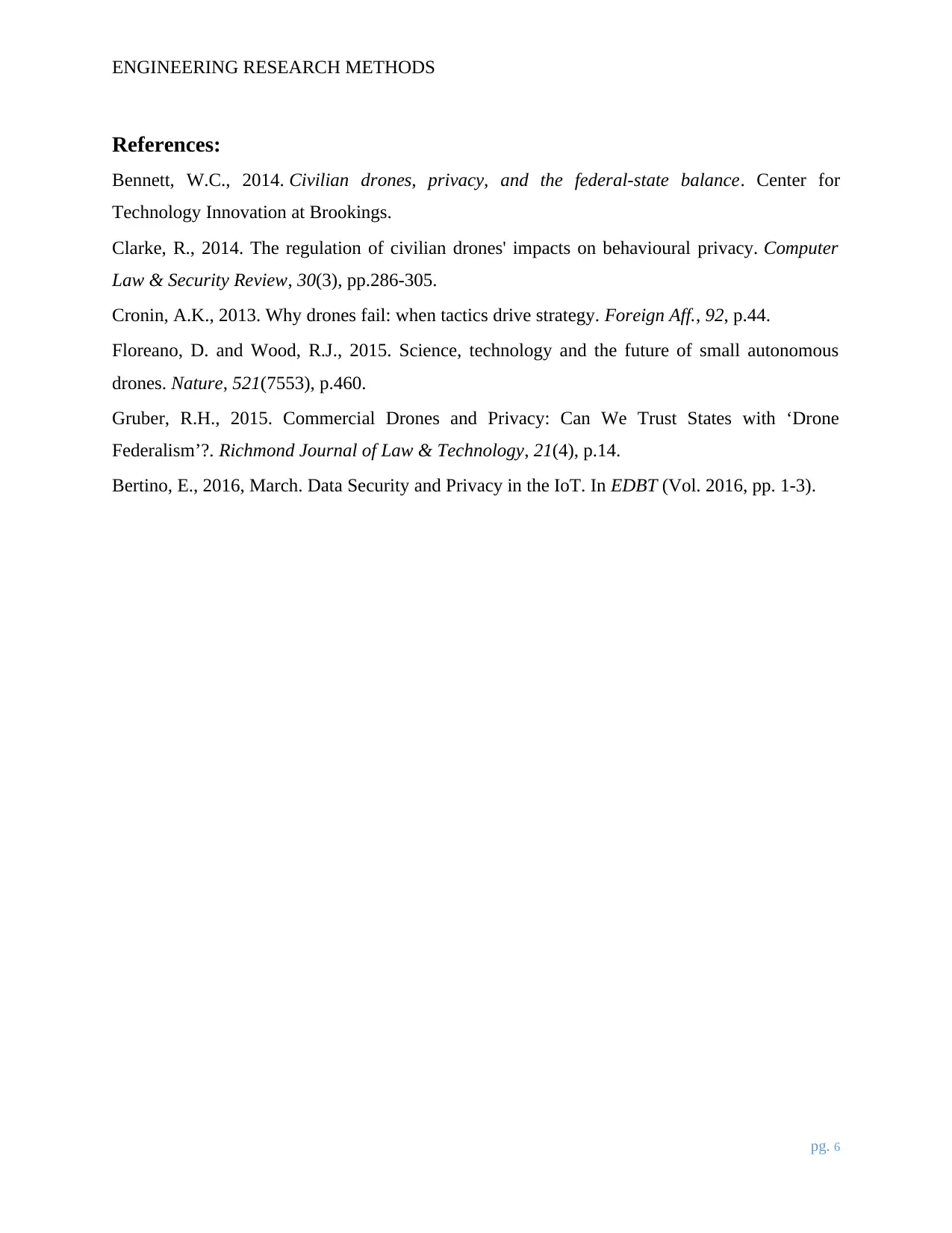
ENGINEERING RESEARCH METHODS
References:
Bennett, W.C., 2014. Civilian drones, privacy, and the federal-state balance. Center for
Technology Innovation at Brookings.
Clarke, R., 2014. The regulation of civilian drones' impacts on behavioural privacy. Computer
Law & Security Review, 30(3), pp.286-305.
Cronin, A.K., 2013. Why drones fail: when tactics drive strategy. Foreign Aff., 92, p.44.
Floreano, D. and Wood, R.J., 2015. Science, technology and the future of small autonomous
drones. Nature, 521(7553), p.460.
Gruber, R.H., 2015. Commercial Drones and Privacy: Can We Trust States with ‘Drone
Federalism’?. Richmond Journal of Law & Technology, 21(4), p.14.
Bertino, E., 2016, March. Data Security and Privacy in the IoT. In EDBT (Vol. 2016, pp. 1-3).
pg. 6
References:
Bennett, W.C., 2014. Civilian drones, privacy, and the federal-state balance. Center for
Technology Innovation at Brookings.
Clarke, R., 2014. The regulation of civilian drones' impacts on behavioural privacy. Computer
Law & Security Review, 30(3), pp.286-305.
Cronin, A.K., 2013. Why drones fail: when tactics drive strategy. Foreign Aff., 92, p.44.
Floreano, D. and Wood, R.J., 2015. Science, technology and the future of small autonomous
drones. Nature, 521(7553), p.460.
Gruber, R.H., 2015. Commercial Drones and Privacy: Can We Trust States with ‘Drone
Federalism’?. Richmond Journal of Law & Technology, 21(4), p.14.
Bertino, E., 2016, March. Data Security and Privacy in the IoT. In EDBT (Vol. 2016, pp. 1-3).
pg. 6
1 out of 7
Related Documents
Your All-in-One AI-Powered Toolkit for Academic Success.
+13062052269
info@desklib.com
Available 24*7 on WhatsApp / Email
![[object Object]](/_next/static/media/star-bottom.7253800d.svg)
Unlock your academic potential
Copyright © 2020–2025 A2Z Services. All Rights Reserved. Developed and managed by ZUCOL.




